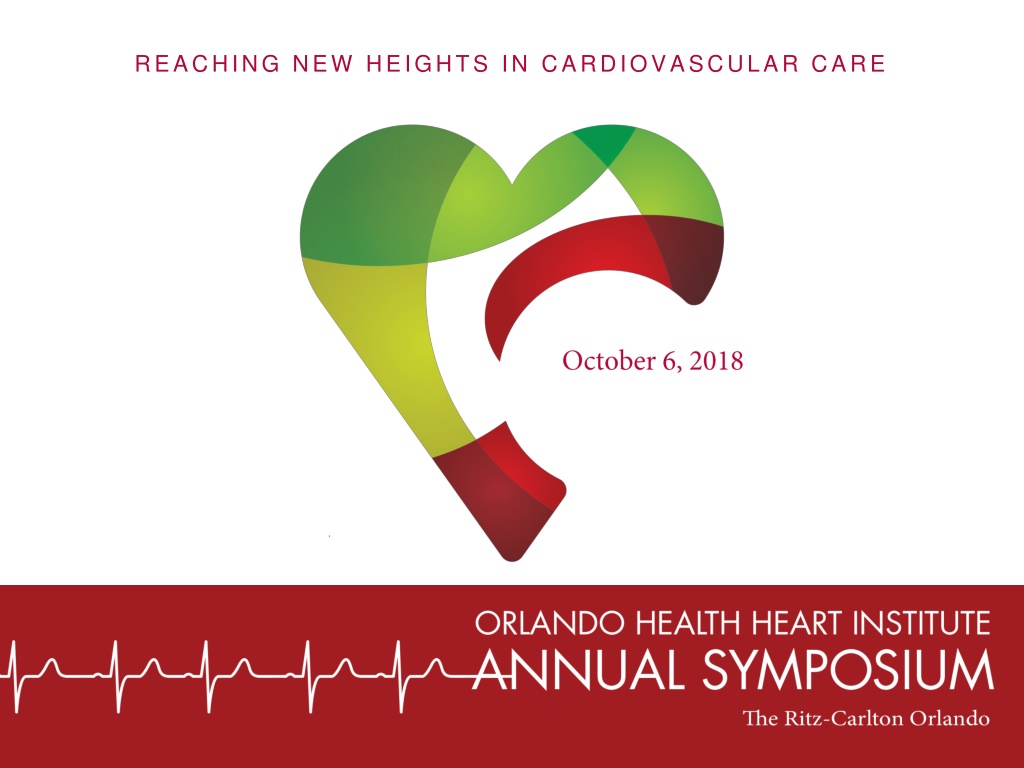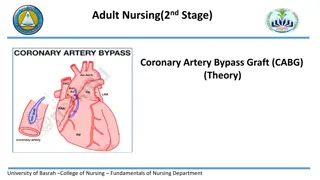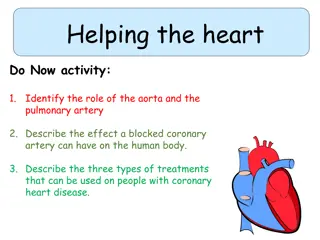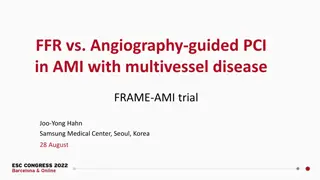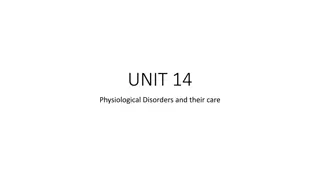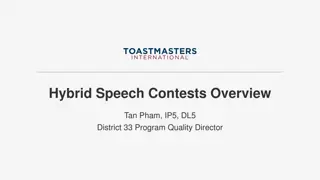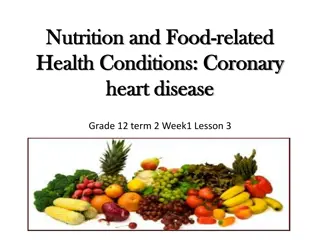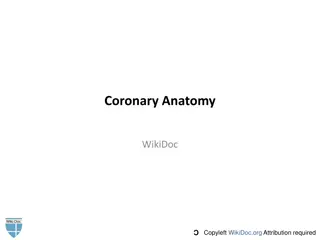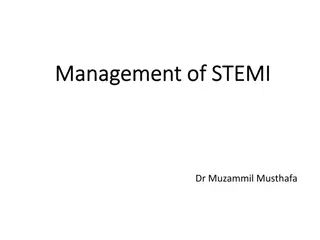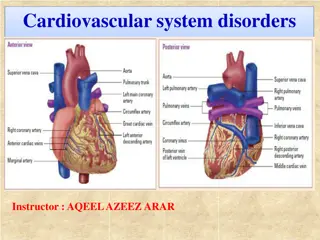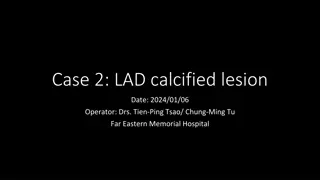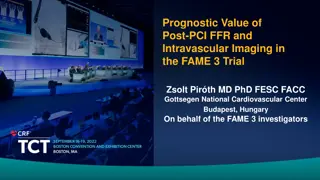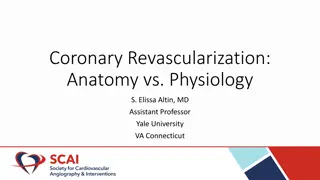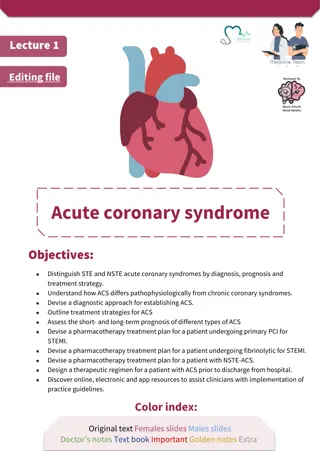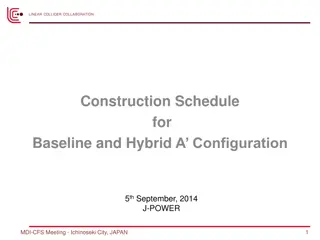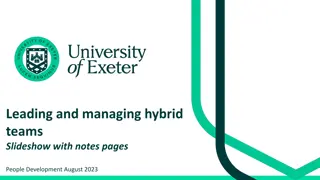Advancements in Hybrid Coronary Revascularization
Explore the evolution of hybrid coronary revascularization in cardiovascular care, guided by the 2011 ACC/AHA guidelines. This groundbreaking approach combines LIMA-to-LAD grafting with PCI for complex CAD cases, offering a promising alternative to traditional CABG or multivessel PCI. The integration of heart teams and collaboration between cardiologists and cardiothoracic surgeons play a pivotal role in determining patient-specific revascularization strategies, ultimately aiming to improve outcomes and enhance the risk-benefit ratio of procedures.
Download Presentation

Please find below an Image/Link to download the presentation.
The content on the website is provided AS IS for your information and personal use only. It may not be sold, licensed, or shared on other websites without obtaining consent from the author.If you encounter any issues during the download, it is possible that the publisher has removed the file from their server.
You are allowed to download the files provided on this website for personal or commercial use, subject to the condition that they are used lawfully. All files are the property of their respective owners.
The content on the website is provided AS IS for your information and personal use only. It may not be sold, licensed, or shared on other websites without obtaining consent from the author.
E N D
Presentation Transcript
HYBRID CORONARY REVASCULARIZATION Steven J. Hoff, MD
Disclosures Consultant/Peer trainer-Medtronic
Hybrid Coronary Revascularization Guidelines/Rationale for HCR Indications and Contraindications HCR logistics HCR results RCT of HCR
2011 ACC/AHA Guidelines for PCI and CAB Strongly recommend Heart Teams to determine best way to revascularize patients who present with unprotected LM stenosis or complex CAD (3V CAD or 2VCAD involving prox LAD) (Class 1, Level of Evidence C)
2011 ACC/AHA Guidelines for PCI and CAB Call for an unprecedented collaboration among cardiologists and cardiothoracic surgeons in generating recommendations for patients with advanced CAD Heart Team concept introduced during SYNTAX Trial Prominently used again in PARTNER Trial
2011 ACC/AHA Guidelines for PCI and CAB Hybrid Coronary Revascularization Class IIa 1. Hybrid coronary revascularization (defined as the planned combination of LIMA-to-LAD artery grafting and PCI of 1 non-LAD coronary arteries) is reasonable in patients with 1 or more of the following. (Level of Evidence: B): a. Limitations to traditional CABG, such as heavily calcified proximal aorta or poor target vessels for CABG (but amenable to PCI); b. Lack of suitable graft conduits; c. Unfavorable LAD artery for PCI (ie, excessive vessel tortuosity or chronic total occlusion). J Thorac Cardiovasc Surg. 2012 May;143(5):1235 Circulation. 2011;124:2610-2642
2011 ACC/AHA Guidelines for PCI and CAB Hybrid Coronary Revascularization Class IIb 1. Hybrid coronary revascularization (defined as the planned combination of LIMA-to-LAD artery grafting and PCI of non-LAD coronary arteries) may be reasonable as an alternative to multivessel PCI or CABG in an attempt to improve the overall risk-benefit ratio of the procedures. (Level of Evidence: C) J Thorac Cardiovasc Surg. 2012 May;143(5):1235 Circulation. 2011;124:2610-2642
2014 Focused Update Recommendations Class I 1. A Heart Team approach to revascularization is recommended in patients with diabetes and complex multivessel CAD (Level of Evidence: C)
Hybrid Coronary Revascularization Surgical Contribution Patient population increasingly challenging Older, sicker, worse disease LIMA-LAD confers long-term survival advantage LIMA protects proximal LAD territory against MI from progressive disease
Hybrid Coronary Revascularization Interventional Contribution PCI is less invasive, allows rapid recovery, and fewer short term complications Interventionalists more aggressive (3V, LM, DM) Saphenous vein patency maligned (up to 20% failure at 6 months) Modern DES patency similar to SVG in non-LAD Cardiologists often see patients first
Hybrid Coronary Revascularization LIMA-LAD PCI to non-LAD territories Best of both worlds Combines durability of CAB to critical LAD territory with minimal invasiveness of PCI
Modern Hybrid Coronary Revascularization Minimally invasive approach to LIMA-LAD Sternal-sparing incision Avoid aortic manipulation and CPB Results in fewer adverse neurologic, hemorrhagic, infectious, pulmonary outcomes
Indications for HCR Limited/absent conduit Severe ascending aortic atherosclerosis High risk for conventional surgery/sternotomy Elderly Disabled/deconditioned Steroids/Immune suppression Interventional issues Complex bifurcation lesion LM disease Patients desiring MI/sternal sparing approach
Absolute Contraindications for HCR-CAB Same for trans-sternal MV OPCAB Hemodynamic instability Cardiogenic shock Malignant arrhythmias
Relative Contraindications for HCR-CAB Inability to tolerate single lung ventilation (Can use low volume DLV) Very low EF/enlarged heart Morbid obesity Reoperation Pericardial/pleural adhesions LIMA unusable (diseased/irradiated/stenotic)
Relative Contraindications for HCR-PCI Anatomy suboptimal for PCI Allergic/Non-responders to anti-platelet agents Severe PVD/other access issues Severe renal dysfunction
Timing Options for HCR Staged PCI before Mini-CAB Staged Mini-CAB before PCI Combined Mini-CAB/PCI in Hybrid OR
Surgical Options in HCR Direct Vision MIDCAB Thoracoscopic Robotic EndoACAB TECAB
MICS CAB Supine position Double lumen ETT 5-7 cm anterolateral thoracotomy incision allows access to the 4thor 5thICS
MICS CAB LIMA harvest with specially designed retractor Provides superior visualization with rib spread and chest wall elevation Harvest under direct vision with standard cautery/instruments
MICS CAB Proximal anastomosis hand sewn or facilitated Stabilizer/Positioner placed through 2cm counterincisions Distal anastomosis standard off-pump technique, instruments
Results of HCR Under 1500 patients reported in literature Early Reports Extremely low 30-day mortality (0.2%) Extremely high LIMA patency (98.8%) Too much variability in approaches to generalize recommendations Multiple recent reviews Modern Surgical Approaches Modern HCR (MiniCAB + DES) HCR vs OPCAB
Early HCR Results Year N Author Mortality (%) LIMA Patency (%) Target Vessel Restenosis F/U (mos) Survival (%) Zenati Lloyd Lewis Wittwer Isomura De Canniere Presbitero Cisowski Stahl Angelini Riess Lee Davidavicius Us Katz Gilard Reicher Zhao Gao 1999 1999 1999 1999 2000 2001 2001 2002 2002 2002 2002 2004 2005 2006 2006 2007 2008 2009 2009 31 18 14 35 37 20 42 50 54 6 57 6 20 17 27 70 13 112 10 0 0 0 0 0 0 2 0 0 0 0 0 0 0 0 1.4 0 2.6 0 100 100 100 100 100 100 92 100 100 NR 98 NR 100 100 96 NR 93 100 100 10 6 0 7 NR 5 14 10 NR NR 24 16 0 18 26 2.3 7 6 NR 11 18 1.4 11 0.2 24 18 12 12 NR 24 12 19 21 3 33 14 42 NR 90 89 93 87 92 95 83 87 87 NR NR NR 100 87 70 97 86 88 NR
Modern HCR results Author Year Patients Surgical LIMA patency (%) Mort (%) TVR (%) Event-free Survival(%) Procedure Vassiliades 2006 47 TECAB 100 0 6.6 90 Bonatti 2007 5 Robotic EndoACAB MIDCAB 100 0 0 100 Kon 2008 15 100 0 3 93 Kiaii 2008 58 Robotic EndoACAB MIBCAB TECAB Robotic EndoACAB 93 0 10.3 NR Holzhey 2008 107 10 50 99 1.9 4.2 86 Srivastava 2010 98.2 0 NR NR
Results of Minimally Invasive Surgical Revascularization Year Surgical Technique (%) Author Patients Mort LIMA patency (%) MACCE (%) Hosp stay (days) Conversion deCannierre 2007 Robotic 117 on- pump 111 off- pump 450 214 56 150 196 164 off- pump 1768 2.1 96 NR NR 28 McGinn Srivastava Hoff LaPierre Bonatti Srivastava 2009 MIDCAB 2010 Robotic 2011 MIDCAB 2011 MIDCAB 2012 Robotic 2012 Robotic 1.3 0 0 0 2.0 0.6 100 100 93 0.7 NR 99 0.4 0 1.8 0 4.0 NR 6 NR 7 5 6 NR 3.8 1.8 6.7 NR 0 Holzhey 2012 MIDCAB 0.8 96 0.4 NR NR
Results of Modern HCR vs. OPCAB Pati ents Mort ality MA CCE Target revasc Vessel ularization Surv ival Author Year HCR OPCAB HCR OPCAB HCR OPCAB HCR OPCAB HCR OPCAB Kon 2008 15 30 0 0 0 10 7 0 100 100 Vassiliades 2009 91 4175 0 1.8 1.1 3 0.3 0 NR NR Halkos 2011 147 588 0.7% 0.9% 2.0% 2.0% 12.2 3.7 86.8 84.3 Hu 2011 104 104 0 0 1.0 9.6 1.0 2.9 100 99 Bachinsky 2012 25 27
RANDOMIZED TRIAL OF HYBRID CORONARY REVASCULARIZATION VERSUS PERCUTANEOUS CORONARY INTERVENTION Sponsored By NHLBI
HCR Trial-Objectives To evaluate the effectiveness and safety of hybrid coronary revascularization (HCR) compared to multi vessel percutaneous cardiac interventions (PCI) with drug-eluting stents (DES) in patients with multi-vessel coronary artery disease (CAD) involving the Left Anterior Descending (LAD) and/or Left Main (LM) arteries. The primary objective of this trial is to determine whether hybrid coronary revascularization is associated with a reduction in Major Adverse Coronary and Cerebrovascular Events (MACCE) compared to PCI with DES.
HCR Trial-Study Design Prospective, randomized, multi-center, comparative effectiveness trial; patients randomized with equal allocation (1:1). Baseline and peri-procedural data collection will be extracted directly from the Society of Thoracic Surgeons (STS) Data Registry and the National Clinical Data Registry (NCDR) Cath/PCI databases. Follow-up data will focus on patient-reported MACCE and QOL. Cost data collected from the University Health Consortium (UHC) or individual hospitals.
HCR Trial Target Population Patients with multi-vessel CAD involving the LAD distribution with a clinical indication for revascularization and eligible for both HCR and multi-vessel PCI with DES. Rx arms HCR with Left Internal Mammary Artery (LIMA) to LAD + PCI of non-LAD vessels Multi-vessel PCI with DES, including the LAD
HCR Trial Sample Size 2354 patients; Accrual over 2 years 70 sites North America and Europe Data Coordinating Center-Mt. Sinai School of Medicine, New York
HCR Trial- 1 Endpoints The occurrence of MACCE defined as all-cause mortality, myocardial infarction (MI), stroke, and repeat revascularization over a minimum of 5 year follow-up after randomization
HCR Trial- 2 Endpoints Hospitalizations Re-hospitalization (all-cause and cardiovascular) Health Status Angina Score (Canadian Cardiovascular Society Classification [CCSC]) Quality of Life (SF-12 and EuroQOL) Cost-effectiveness Costs Quality-adjusted life expectancy
HCR Trial- 2 Endpoints Cardiovascular Events MACCE at each data collection time point Individual components of MACCE All-cause mortality Repeat revascularization (all-cause) Stroke Myocardial infarction (MI) Ischemia-driven repeat revascularization Cardiovascular mortality
Hybrid Trial Sites-North America Randomized Patients / # of Weeks Activated 0.65 0.39 0.42 0.25 0.17 0.35 0.19 0.18 0.14 0.12 0.11 0.11 0.12 0.12 0.07 0.06 0.06 0.06 0.06 0.05 0.03 0.03 0.03 0.00 0.00 0.00 0.00 0.00 0.00 Randomized Patients (n) 30 19 15 9 7 6 6 6 6 4 4 4 3 2 2 2 2 2 2 2 1 1 1 0 0 0 0 0 0 # of Weeks Activated 46 48 36 35 41 17 31 34 42 34 36 36 25 16 28 32 32 35 36 38 29 32 38 3 9 11 24 26 34 Weeks Since Last Randomization 1.3 6.0 7.1 1.3 17.4 2.1 12.3 3.0 11.0 3.3 7.3 21.0 7.1 5.1 12.9 1.0 18.9 1.3 6.3 5.9 18.0 30.9 0.4 - - - - - - Interventional PI John Fox Varinder Singh Giora Weisz Molly Szerlip Henry Liberman rick Schampeart Matthew E. Wiisanen Michael Ragosta Ajay Kirtane Patrick Teefy Vijay Iyer Ayman Iskander Mark Vesely John K. Forrest William Bachinsky Christian Witzke Murali Muppala Mark Steiner William Matthai Timothy Shapiro Byron K. Ellis Phillip A. Horwitz Eric Elgin Ibrahim Moussa Ganesh Raveendran Konstantinos Boudoulas William Fearon Julio Bird William M. Suh Surgical PI Research Coordinator Miguel Bravo Effe Mihelis Agnieszka Siemienik Brittany Zingler Mary McBride Carole Sirois Michelle Rice Allison Raymond Alex Kantor Stephanie Fox Marlene Wilde Laura Mowers Rimma Zakharyan Marianne McCarthy Gretchen Meise Carrie Malaczewski Jane Wernow Pamela Peisner Mary Lou Mayer Lisa Thome Sheila Moore Kim Miller-Cox Julie Sheidy Danielle Connors Coley Landvik Luba Mazanec Kokil Bakshi Kim Halverson Samantha Solis Mount Sinai Health System Northwell Health Montefiore - Einstein Baylor Research Institute-Plano Emory University Centre Int gr Universitaire Erlanger Health University of Virginia Columbia University London Health Sciences Centre Buffalo General Medical Center St Joseph's Hospital Health Center University of Maryland Yale University PinnacleHealth Cardiovascular System Einstein Healthcare Network HealthPark Medical Center Orlando Health Heart Institute University of Pennsylvania Lankenau Medical Center Houston Methodist Sugarland University of Iowa Reading Hospital Our Lady of Lourdes Medical Center University of Minnesota Ohio State University Stanford University Gundersen Health System UCLA Health John Puskas Nirav Patel Joseph J. Derose Robert Smith Michael Halkos Hugues Jeanmart Larry Shears Gorav Ailawadi Michael Argenziano Bob Kiaii Hashmat Ashraf Zhandong Zhou Bradley S. Taylor Arnar Geirsson David Loran Alexandra Tuluca Paul DiGiorgi Steven Hoff Pavan Atluri Francis Sutter Uttam Tripathy Mohammed A. Bashir Christine McCarty Arthur Martella Kenneth Liao Bryan Whitson Joseph Woo Prem Rabindranauth Richard J. Shemin
Hybrid Trial Sites-North America Randomized Patients / # of Weeks Activated 0.66 0.40 0.43 0.26 0.17 0.37 0.20 0.18 0.15 0.12 0.11 0.11 0.13 0.13 0.07 0.06 0.06 0.06 0.05 0.04 0.03 0.03 0.00 0.00 0.00 0.00 0.00 0.00 0.00 Randomized Patients (n) 30 19 15 9 7 6 6 6 6 4 4 4 3 2 2 2 2 2 2 1 1 1 0 0 0 0 0 0 0 # of Weeks Activated 45 47 35 34 40 16 30 33 41 33 35 35 24 15 27 31 34 35 37 28 31 31 2 8 10 23 25 33 37 Weeks Since Last Randomization 0.3 5.0 6.1 0.3 16.4 1.1 11.3 2.0 10.0 2.3 6.3 20.0 6.1 4.1 11.9 17.9 0.3 5.3 4.9 17.0 3.1 29.9 - - - - - - - Interventional PI John Fox Varinder Singh Giora Weisz Molly Szerlip Henry Liberman rick Schampeart Matthew E. Wiisanen Michael Ragosta Ajay Kirtane Patrick Teefy Vijay Iyer Ayman Iskander Mark Vesely John K. Forrest William Bachinsky Murali Muppala Mark Steiner William Matthai Timothy Shapiro Byron K. Ellis Christian Witzke Phillip A. Horwitz Ibrahim Moussa Ganesh Raveendran Konstantinos Boudoulas William Fearon Julio Bird William M. Suh Eric Elgin Surgical PI Research Coordinator Miguel Bravo Effe Mihelis Agnieszka Siemienik Brittany Zingler Mary McBride Carole Sirois Michelle Rice Allison Raymond Alex Kantor Stephanie Fox Marlene Wilde Laura Mowers Rimma Zakharyan Marianne McCarthy Gretchen Meise Jane Wernow Pamela Peisner Mary Lou Mayer Lisa Thome Sheila Moore Carrie Malaczewski Kim Miller-Cox Danielle Connors Coley Landvik Luba Mazanec Kokil Bakshi Kim Halverson Samantha Solis Julie Sheidy Mount Sinai Health System Northwell Health Montefiore - Einstein Baylor Research Institute-Plano Emory University Centre Int gr Universitaire Erlanger Health University of Virginia Columbia University London Health Sciences Centre Buffalo General Medical Center St Joseph's Hospital Health Center University of Maryland Yale University PinnacleHealth Cardiovascular System HealthPark Medical Center Orlando Health Heart Institute University of Pennsylvania Lankenau Medical Center Houston Methodist Sugarland Einstein Healthcare Network University of Iowa Our Lady of Lourdes Medical Center University of Minnesota Ohio State University Stanford University Gundersen Health System UCLA Health Reading Hospital John Puskas Nirav Patel Joseph J. Derose Robert Smith Michael Halkos Hugues Jeanmart Larry Shears Gorav Ailawadi Michael Argenziano Bob Kiaii Hashmat Ashraf Zhandong Zhou Bradley S. Taylor Arnar Geirsson David Loran Paul DiGiorgi Steven Hoff Pavan Atluri Francis Sutter Uttam Tripathy Alexandra Tuluca Mohammed A. Bashir Arthur Martella Kenneth Liao Bryan Whitson Joseph Woo Prem Rabindranauth Richard J. Shemin Christine McCarty
NIH Hybrid Trial THIS IS A CARDIOLOGY TRIAL and will require enthusiastic engagement of (Interventional) Cardiology to succeed. Hybrid anatomy : prox/mid LAD plus at least one other non-LAD lesion requiring revascularization; LM bifurcation lesion Typically low SYNTAX score patients who are commonly treated with multivessel PCI Protocol changes remove barriers to enrollment (ISR/MIDCAB)
NIH Hybrid Trial Two (2) routes of entry to this trial: Diagnostic cath showing hybrid-eligible CAD Cath/PCI for ACS (NSTEMI or STEMI) Diagnostic cath pathway: Cath, diagnosis of hybrid-eligible CAD Consent, randomization Multivessel PCI or LIMA-LAD followed by PCI Cath/PCI for ACS pathway: Cath and PCI of non-LAD culprit lesion(s) Diagnosis of bystander LAD lesion Consent, randomization Second PCI or LIMA-LAD (possibly followed by another PCI)
New International Sites-HCR Trial AKH Vienna AUSTRIA Clinical Center of SERBIA Cardiology Dept Med Univ of d POLAND St. Paul's Hospital Vancouver, CANADA Hospital Do Coracao Do, Sao Paolo, BRASIL Hippokration Hospital Athens, GREECE Clinica Mediterranea Naples, ITALY Red Cross Hospital Lisbon PORTUGAL Medical University of Gdansk POLAND Aarhus University Hospital; Skejby, DENMARK Hospital Universitario Central de Asturia SPAIN
New International Sites-HCR Trial Hospital do cora o do BRASIL IRCCS San Raffaele Hospital ITALY HUCAM-UFES: Hospital Universit rio Cassiano Antonio Moraes, Universidade Federal do Esp rito Santo SPAIN Hospital virgen de la victoria. Malaga, SPAIN Azienda Ospedaliera di Padova ITALY Humanitas Research Hospital ITALY Saud Al Babtain Cardiac Center, Damma, SAUDI ARABIA Northwick Park Hospital and Royal Brompton Hospital ENGLAND
Summary Hybrid Coronary Revascularization (HCR) is a reasonable guideline driven treatment strategy in patients with complex multivessel CAD Early results show HCR is safe and effective An enrolling international RCT comparing HCR to PCI for multivessel CAD may help to define the role of HCR in the treatment of patients with complex CAD
